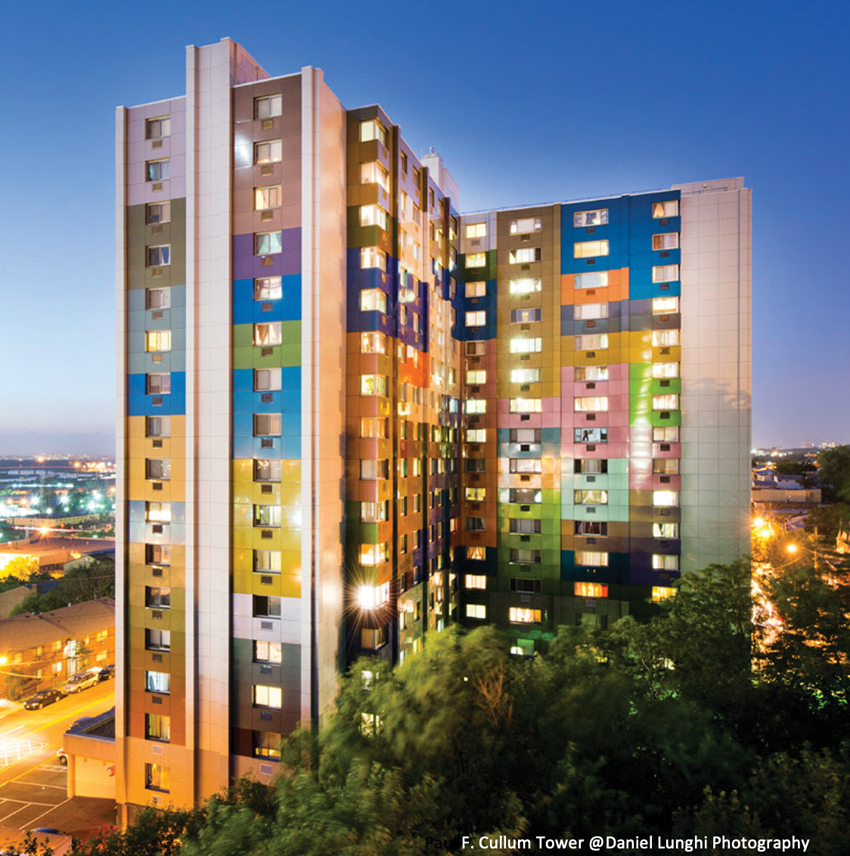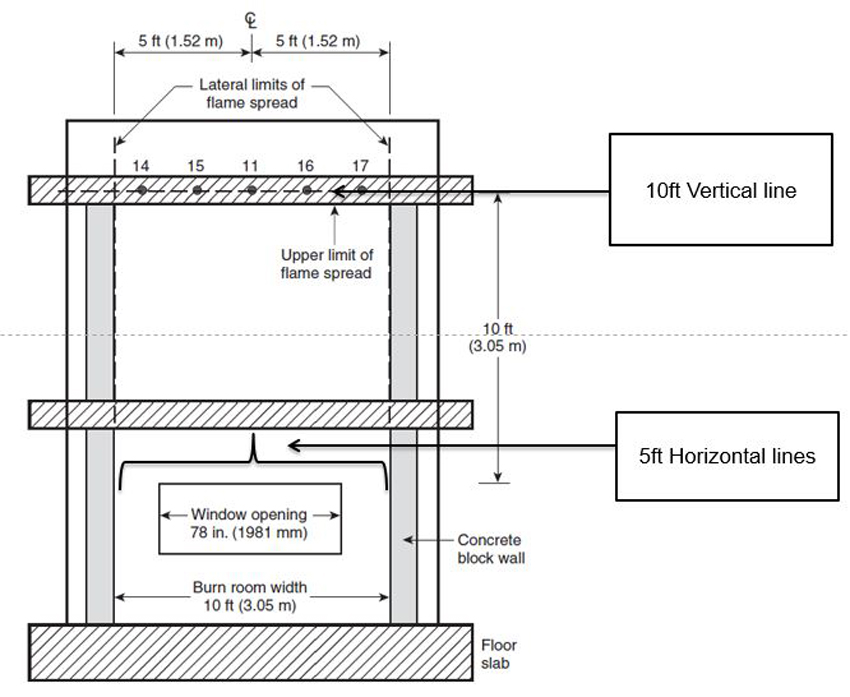Cladding Safety with Metal Composite Material (MCM) and the NFPA 285-19

Photo courtesy of Daniel Lunghi Photography/ALUCOBOND
At the Paul F. Cullum Tower in North Bergen, N.J., metal composite material cladding offers a flame-retardant, colorful facade.
Commenting on the significance of these additions, Keith Nelson, NCARB, AIA, CDT, BCXP, principal, department manager, ECS Mid-Atlantic, Richmond says, “The changes made in the 2019 version of NFPA 285 are significant and will have an impact on the industry and the use of this standard in design and construction projects.”
He explains that system joints are often the most vulnerable component of a wall assembly. Whereas NFPA 285’s former testing protocols did not include joint location requirements, the updated version requires that the joint is located above the centerline of the window.
“At least one vertical joint must run the entire height of the assembly and at least one horizontal joint must run the entire width of the assembly,” explains Gerald Schultz, P.E., The FPI Consortium Inc., Woodridge, Illinois. “These changes attempted to address the weakest point of a wall assembly.”
As opposed to only testing a surface-burning fire, by testing the assembly with joints in these locations, the potential impact of the fire on the cavity behind the exterior cladding is more severe, and a truer reflection of the system’s ability to withstand fire propagation.
In addition, Ray Grill, P.E., Ray Grill Consulting, PLLC, Clifton, Virginia, explains that as opposed to the previous NFPA version that was only applicable to exterior wall assemblies required to be noncombustible, NFPA 285-19 also applies to exterior wall assemblies for all types of construction that exceed 40 feet in height.
The actual changes were made to enhance life safety in buildings and to make testing amongst manufacturers more uniform. While NFPA 285-19 won’t become an enforceable standard until municipalities adopt the 2021 IBC, as good stewards believing that it is the right thing to do, many manufacturers have already tested their products to ensure compliance with NFPA 285-19 requirements.

Image courtesy of the Metal Construction Association
To pass the NFPA 285 two-story test, the fire cannot propagate more than 10 feet above the window opening and the horizontal spread cannot be more than 5 feet from the centerline of the window.
The NFPA 285 Test
FPA 285-19 is an assembly test for exterior walls that contain combustible components or materials. The test determines vertical and horizontal flame spread by simulating an interior flashover fire that impacts the exterior cladding through a compromised window opening. It’s important to stress the fact that NFPA 285 is a large-scale assembly test.
“The test is a two-story test to examine the potential for fire spread… the entire assembly needs to be considered and can have an impact on performance,” explains Grill.
This means that individual products and systems cannot pass the test individually. Materials are only considered acceptable when evaluated in conjunction with the entire wall assembly.
The testing evaluates an assembly under the conditions of a post-flashover fire originating inside a building. Flashover is a dangerous phenomenon in fire behavior, as the heat energy of a fire radiates to all the contents of an enclosed area, eventually causing them to reach ignition temperature. Flashover is the moment of full-room involvement when all the combustible contents in the space autoignite simultaneously.
By simulating the worst-case scenario, the new 2019 requirements more accurately reflect how an assembly could perform in a “worst case” construction in the event of a fire. In particular, by locating the vertical joint in the test sample at the center of the window opening, the joint is exposed to the flame plume coming from both the burn room and external burner. “Locating the horizontal joint within 3 feet of the window header also exposes it to the flames emanating from the window opening,” adds Andy Williams, P.E., director of codes and standards, Metal Construction Association.
In terms of the actual test apparatus, the apparatus is built with a two-story structure that is 18 feet high, with test rooms on each story that measure 10 feet wide and 10 feet deep, with a minimum floor-to-ceiling height of 7 feet. The test specimen completely closes the burn rooms of the test structure, except for a 20-inch-by-78-inch window opening on the first story.
In order to pass the test, the assembly must show that the vertical fire will not progress more than 10 feet above the window opening and that horizontal spread is not more than 5 feet from the centerline of the window.
To simulate a fire, one gas-fired burner is located in the interior of the first-level burn room and a second moveable burner is located on the exterior by the window header. First, the interior burner is ignited, followed by the window burner five minutes later. The burners alternately increase in fuel load every five minutes. After 30 minutes, both burners are shut off.
Whereas wood was traditionally used as the fire source in the original full-scale, multistory test, gas is now utilized to produce a more consistent heat source. In addition, the window in the testing apparatus does not include glass. In simulating the fire, it is assumed that the glass would have already broken out.
Ultimately, the NFPA 285 test is very difficult to pass. Consequently, assemblies which do pass the test offer a high level of assurance for the fire protection and safety of building occupants.
In order to pass this rigorous test, the following conditions must be met:
- Vertical flames are not visually observed on the exterior wall 10 feet or higher above the window opening header.
- The thermocouples at 10 feet vertically from the window opening do not exceed 1,000°F.
- Flames are not visually observed on the exterior wall horizontally 5 feet or further from the center of the opening.
- The thermocouples at 5 feet horizontally from the window opening do not exceed 1,000°F.
- Temperature rise does not exceed 500°F within the second-story test room, measured 1 inch from the interior wall assembly surface.
- Smoke and flame cannot visually be observed within the second-story test room.
- Regarding the wall cavity, temperature rise cannot exceed 1,000°F within any wall cavity air space.
- Temperature rise does not exceed 750°F within any combustible wall components more than ¼-inch thick.









